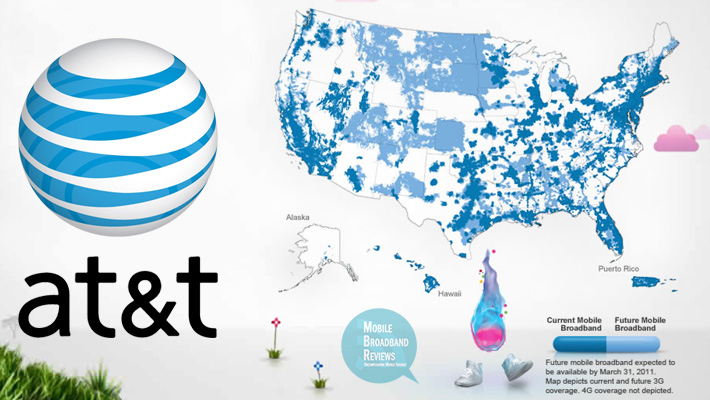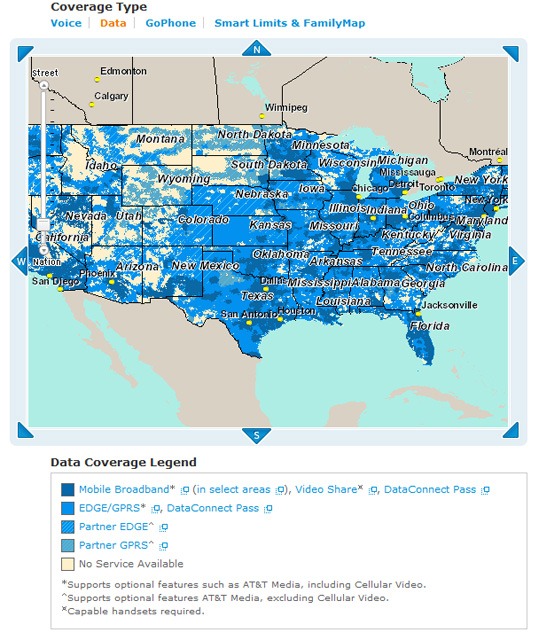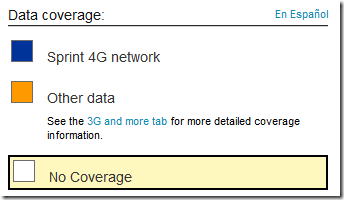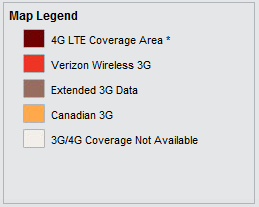
If you’re interested in AT&T, check out the AT&T 4G Coverage | 2012 Review for the latest. This is a dated review.
Since last year’s 3G Coverage Review, AT&T has publicized plans to expand current 3G coverage in addition to 4G coverage with both HSPA+ and LTE throughout 2011 and beyond.
Most recently, they’ve announced a merger with T-Mobile to cover 95% of the United States population with 4G LTE coverage.
However, the bundling 2G, 3G & 4G coverage information on one map without distinctions for each speed tier serve to confuse prospective and existing users as to where they can access the various advertised 3G and 4G speeds.
AT&T Has 2 Coverage Maps | Confusion
The first is the official AT&T Coverage Viewer available here:

The first thing to notice is that there’s no mention of 4G coverage. Instead, there’s the blanket statement of ‘mobile broadband’ that can include 3G, 4G, HSPA, HSPA+, LTE and everything there after. One glance at the map above may give the impression that AT&T has nationwide 3G coverage. However, partner EDGE/GPRS as well as AT&T’s EDGE/GPRS are 2G dialup-like speeds.
While industry experts may know that the underlying technology AT&T uses for mobile broadband at the moment is HSPA and increasingly HSPA+ with plans for LTE throughout 2011, the average consumer may not. While AT&T may not have to use industry jargon like HSPA, HSPA+ & LTE since it may be confusing for the customer, distinctions of 3G and 4G aren’t optional.
Verizon and Sprint, for example, have distinct buttons and tabs dedicated to show 4G LTE and WiMAX coverage respectively. They allow customers to make buying decisions based on the kind of speed they can expect in their respective coverage areas. Setting customer expectations reduces churn rates (switching carriers), buyer’s remorse and is practical business sense.
Out of Verizon, Sprint & T-Mobile, AT&T is the only carrier that colors dialup speed coverage in a similar color to their own data coverage. It seems insignificant at first but gives the appearance of a much larger data coverage area to the unsuspecting eye.
Verizon
Sprint

AT&T

T-Mobile

The ‘AT&T 4G Coverage Map’
Upon scrolling over the entire AT&T 4G Coverage Map, 11 orange dotted areas ‘popped up’ for ‘detailed local 4G coverage maps’:
- Northern California
- Los Angeles
- Greater Dallas, TX
- Houston, TX
- Chicago, IL
- Buffalo, NY
- Boston, MA
- Providence, RI
- Baltimore, MD
- Charlotte, NC
However, the fine print reads “map depicts current and future 3G coverage. 4G coverage not depicted”. Upon closer inspection of the legend, there are two distinctions: current mobile broadband and future mobile broadband.
Red flag.
The page headlines, sub-headlines and subsequent text all emphasize 4G speed elegantly aligned next to a map where “4G coverage is not depicted”, a notice faintly labeled in fine print and blended in a shade of gray on a gray background.
Contrast this with Verizon and Sprint’s 4G coverage maps that have specific buttons and tabs dedicated to showing explicitly and separately their 4G coverage along with address tools to check coverage at the street level.
In the map’s default state, there are no 4G cities highlighted or indicated. You have to search for them yourself. Upon first try, I found 2 in California. On my second try, I found 11.
Requiring customers to play ‘hide and go seek 4G coverage’ is not an effective marketing strategy.
At the very least, AT&T should clearly list the cities where 4G coverage is and will be available. Secondly, they need an address tool for customers to see if coverage is at least available in their city or zip code.
Side note: AT&T 4G Coverage isn’t actually 4G.
Like T-Mobile, they’ve rebranded HSPA+, an upgraded version of their current HSPA 3G technology, to provide faster speeds while they play catch up in building their new network that runs on the same technology as Verizon’s 4G LTE. However, since the speeds are comparable to Sprint 4G and faster than what they have right now, they’ve decided to call it 4G.
– AT&T 4G Speed Review | 2011 Mobile Broadband Review
For the areas that do have AT&T ‘4G Coverage’ you’ll need a 4G-capable device. Since AT&T 4G plans are cheaper than their 3G plans by $10 and have approximately 1000% lower overage fees per GB, having a 4G broadband card or mobile hotspot may very well save you money and future proof you for future upgrades.
AT&T 4G LTE Coverage
With T-Mobile, AT&T can deploy 4G LTE to 95% of U.S. population, enabling network capacity for the U.S. high-tech industry and a virtuous cycle of innovation and growth
AT&T via Mobile Everything
While this won’t change much about the mid-2011 LTE launch plans, it will have a drastic effect on competing with Verizon’s LTE network in the long-run.
Next, AT&T 4G Broadband Cards
In the next installment, I’ll compare the best of AT&T 4G broadband cards and mobile hotspots available for you to do just that.
Also in this review:
- AT&T 4G Review
- AT&T 4G Plans
- AT&T Prepaid Mobile Broadband
- AT&T 4G Speed
- AT&T 4G Coverage
- AT&T 4G Broadband Cards & Mobile Hotspots
Also check out: The 4G Comparison Infographic to see how AT&T stacks up against the competition.



Malkowski says:
AT&T is absolutely terrible, their network is so overloaded it’s ridiculous. I have a hard time getting any internet on their 3G network at any point after 8 am anywhere in Las Vegas. I’ve nothing but hatred toward AT&T and can’t wait til I can get out of their overpriced contract. I honestly doubt they’ll have 4G in the next two years, at least not to the extent that it’ll be worth paying for.
Arkansas Ranger says:
No need to whine about your handset, I’ve been to Las Vegas with an iphone 3gs. Your ludicrous statement about service does not hold water. Pay your backdue phone bill and get back on ATT.
Steven says:
Amen Ranger. Everybody gripes about AT&T because they drop calls, or they don’t always get 3G coverage in their bomb shelter, or their phone died because they dropped in the toilet.
Let’s be real here. No carrier in the whole world can guarantee not to drop calls. Nobody will gaurantee service in a bomb shelter. If you break your phone, it’s not because AT&T sucks. You can’t expect to get full bars everywhere, on any carrier; so let’s shut up about that. Every cell phone will drop a call here and there.
My AT&T phone is just fine. I’ve been with them for 6 years, and don’t really see a reason to change. I get service in most reasonable places, it’s very reasonably priced, and they’re a good company to deal with. If I have a problem, they fix it and don’t dick around. AT&T isn’t necessarily the cheapest, but you can’t have everything you want for &11.95 a month.
B-rad says:
I don’t understand why everyone has to cry about coverage, bottom line is that cell phone technology is still in its early days of increased developement. 6 years ago was the true break out of the advanced networks we use now. Hold on to your opinions and save the BS. It took the US military 10 years to improve their HSPA network that has been significantly downgraded for civilian use. AT&T is, however advertising their HSPA and LTE in areas where 85% of ppl dont have coverage. Just beware and do your reasearch, there is no HSPA or LTE for AT&T yet, what were getting is 3G.5 with a max download of 5mbps on a clear day under a tower, it is what it is! Everybody wants everything NOW and thats not the way it is. Move to Japan if you want 100% coverage.